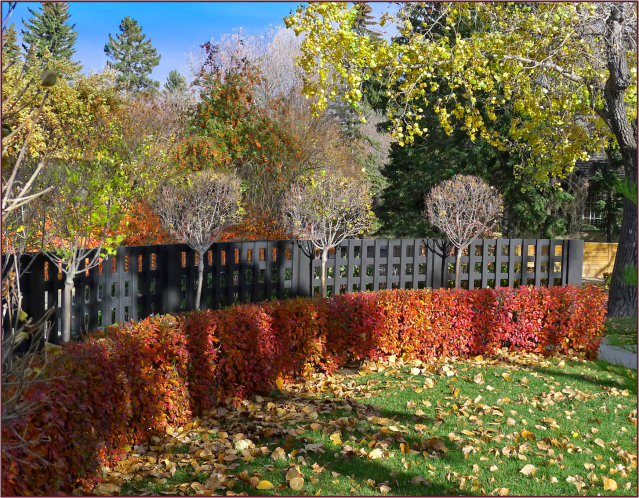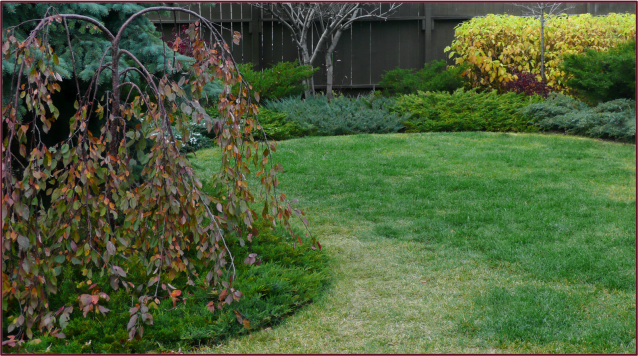A week or so ago, before our balmy fall weather morphed into an early blast of winter, I took a drive through a couple of our city’s more ‘distinguished’ neighbourhoods looking for photo-ops. As I scanned the tastefully landscaped homes, which were all the more attractive with the accompanying hues of autumn, I found myself stopping and starting, braking and rubbernecking to get a better look. Yes I was that nuisance driver you wanted to bellow at: “Get moving lady!” “Move over lady!” “Move lady!”
Move!
My car may not have been moving but my eye certainly was – well designed landscapes invite that. In fact Movement is one of the Design Principles and just happens to be the subject of this post (shameless segue I know). The definition is of course self-explanatory: Movement refers to what keeps the eye in motion throughout a landscape. Of course this visual movement will occur with or without our intervention, but design choices can definitely affect how our eye will move through a garden.
One of the ways we can generate movement is with rhythmic repetition. You’ll recall that I discussed repetition several months ago in reference to Unity. However, repetition as it relates to Movement refers to a design element that is repeated at regular intervals or in an obvious pattern. It can be a single element recurring regularly or a more complex pattern of alternating elements.

Rhythmic repetition of grafted Syringa meyeri standards reinforce movement along this uniquely curving fence. Photo: Sue Gaviller

Picea pungens ‘Glauca Globosa’ & dwarf Pinus mugo alternate in front of the fence, and Populus tremula ‘Erecta’ & upright Picea pungens (unknown cv.) alternate behind the fence, creating effective rhythmic movement. The fence too has rhythm, due to the repeating brick pillars. Photo: Sue Gaviller

Repeating clumps of Calamagrostis acutiflora ‘Karl Foerster’ direct and reinforce movement in two directions. Photo: Sue Gaviller

Straight lines = fast movement. Note how the eye shoots right back to the end of this path – likely the desired effect, i.e. the eye goes directly to the focal point at path’s end. Photo: Marny Estep
We can also affect movement with the design lines we choose. Straight lines, since they’re very direct, generate very fast, forceful movement. Angled lines, though still quite dynamic, are a little slower because they’re less direct – they move across our field of vision at the same time they’re moving with it. Curving lines create the slowest movement. Perhaps this gentle movement explains why curves are favoured by gardeners – a reprieve from our fast paced lives? Remember though that curves need to be big and bold if they’re to have this calming effect – too many small curves just feels busy.

The large curve of lawn space and the alternating blue and green junipers, create good flow and movement in this autumn landscape. Photo: Sue Gaviller
Movement can be affected by plant form as well. Rounded or mounding forms encourage movement – the eye just glides over them and moves on. Upright forms on the other hand, arrest the flow of movement – they literally interrupt our line of vision. For this reason they are useful in a long straight planting – the upright form acts as a visual stop to prevent the eye from reading the entire length at once. However, for this same reason, upright forms (especially very narrow ones) should be used sparingly or a ‘stop and start’ kind of movement results (a bit like my abovementioned driving).

The rhythmic repetition of clipped Buxus shrubs, in addition to their rounded form, creates nice movement along this walkway at Butchart Gardens, Victoria. Photo: Jane Reksten.

The large rounded forms of pruned Cotoneaster lucidus lead the eye to the upright pyramidal Picea pungens which abruptly halts visual movement. Photo: Pat Gaviller
So there you have it fellow gardeners – we’ve waded through yet another Design Principle. Moving on then….
Drive safe, Sue © Sue Gaviller and Not Another Gardening Blog 2012. Unauthorized use and/or duplication of this material without express and written permission from this blog’s author and/or owner is strictly prohibited. Excerpts and links may be used, provided that full and clear credit is given to Sue Gaviller and Not Another Gardening Blog with appropriate and specific direction to the original content.Related articles
- A Question of Balance – The Principled Gardener Part 5 (notanothergardeningblog.com)









